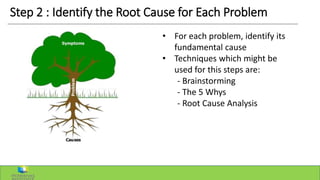Pareto analysis method
- 1. Presented by : E. Sahusilawane Yohan Eko K. Leady Ervine Winerungan DECISION MAKING TOOLS USING PARETO ANALYSIS METHOD
- 2. What is Pareto • Named after Vilfredo Pareto, an Italian economist. He observed in 1906 that 20% of the Italian population owned 80% of Italy's wealth • Pareto Analysis is used to record and analyze data relating to a problem in such a way as to highlight the most significant areas, inputs or issues. • Pareto Analysis often reveals that a small number of failures are responsible for the bulk of quality costs, a phenomenon called the ‘Pareto Principle.’ • This pattern is also called the ‘80/20 rule’ and shows itself in many ways.
- 3. Pareto Principle • Doing 20% of work generates advantage 80% of entire job • In terms of quality improvement, large majority of problems (80%) are created by a few key causes (20% • Example : a. 80% of sales are generated by 20% of customers. b. 80% of Quality costs are caused by 20% of the problems. c. 20% of stock lines will account for 80% of the value of the stock.
- 4. Benefits of Pareto Analysis It helps to improve decision making It is used to bridge the gap between efforts and achievements It helps to grow and develop business It helps to identify crucial problems It helps organization to focus on its core strength
- 5. Step 1 Identify and List Problems Areas Step 2 Identify the Root Cause for Each Problem Step 3 Score each Problems in terms of importance Step 4 Group Problems Together by Root Cause Step 5 Start working on those with highest score Pareto - step by step
- 6. Step 1 : Identify and List Problem Areas • Write a list of all most important causes and problems that you need to consider • If possible, talk to clients, stakeholders and team members to get their inputs
- 7. Problem List Example • The decreased performance of PT A. which previously was the only player for mail & freight delivery service, now has becoming one of the player due to many new competitors. • The trend in the use of the product was decreased along with new technology which offers the easier way to send money and document in a faster way and even real time. • Reduced physical / paper mail delivery with the changing trend to send the electronic document
- 8. Step 2 : Identify the Root Cause for Each Problem • For each problem, identify its fundamental cause • Techniques which might be used for this steps are: - Brainstorming - The 5 Whys - Root Cause Analysis
- 9. PT. A – Root Cause Analysis Business process, Infrastructure & technology • Less responsive and quickly adapt to technological change Corporate Culture PT A. does not have the skillset needed by the logistics industry at this time Human Resources • Employees who are already in the comfort zone • Complicated bureaucracy & long work procedures Business Model A conventional business model that is less adaptive to rapid business development
- 10. Step 3 : Score each Problems in terms of importance • This steps is the most subjective in the process • The scoring method depends on the sort of problem we're trying to solve • Example : a. If we want to improve profits, we might score problems on the basis of how much the cost b. If we're trying to improve customer satisfaction, we might score them on the basis of the number of complaints
- 12. Step 4 : Group Problems Together by Root Cause • Group the problems by similar cause. • For example when we do primary and questionnaire research on PT. A, we obtain that list driver / root cause. • The decreased performance of PT. A is classified into 5 factors as below : 1. Intrinsic 2. Environment 3. Peer & social 4. Supervising 5. Management
- 13. Step 5 : Start working on those with highest score • Start to do calculation of previous scoring to obtain percentage. • This last step will show us which of assumption 20% percentage that influent the percentage of other driver or root cause.
- 14. DRIVER FINDING PERCENTAGE PARETO INTRINSIC 51 22% 80 ENVIRONMENT 52 22% REKAN KERJA & SOSIAL (PEER & SOCIAL) 49 21% SUPERVISING 45 19% MANAGEMENT 35 15% 20 Based on questionnaire and research, it was found that: a. 15% factors or 20% of Pareto assumption is due to lack of Management strategy & control which caused the problems that occur in PT A. b. 80% factors are caused by the intrinsic elements such as the Employees, environment, peer & social. Pareto Analysis on PT. A
- 15. Pareto Chart on PT. A
- 16. Conclusion 1. To be able to compete with competitors, PT. A needs to do a Business Model Transformation in the whole aspect. 2. To adapt with technology and society PT. A needs to build and maximize the usage of E-Commerce channel to gain more revenue. 3. Improvements in management PT. A (20%) is now becoming main priority to get 80% company performance improvement.
















